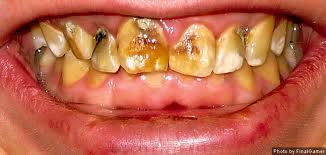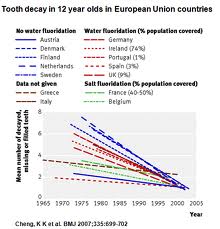How Much Fluoride is Too Much Fluoride: Who Really Benefits?
 There is widespread debate about how much fluoride is safe to consume and whether municipal water systems should be fluoridated. I noticed recently that Sri Lanka marked National Water Safety Week by providing water filters to more than 400 families who were consuming water with too much fluoride. How much fluoride did Sri Lanka think was too much? The families were taking in more than 0.8 mg/liter (mg/l). It’s interesting to note that the U.S. EPA has set the Recommended Maximum Contaminant Level (RMCL) of fluoride in drinking water at 4 mg/l, over four times the amount thought to be unhealthy by the Sri Lankans.
There is widespread debate about how much fluoride is safe to consume and whether municipal water systems should be fluoridated. I noticed recently that Sri Lanka marked National Water Safety Week by providing water filters to more than 400 families who were consuming water with too much fluoride. How much fluoride did Sri Lanka think was too much? The families were taking in more than 0.8 mg/liter (mg/l). It’s interesting to note that the U.S. EPA has set the Recommended Maximum Contaminant Level (RMCL) of fluoride in drinking water at 4 mg/l, over four times the amount thought to be unhealthy by the Sri Lankans.
The Health and Human Services (HHS) and Environmental Protection Agency (EPA) earlier this year proposed lowering the recommended level of fluoride to be added to drinking water from the previous recommended range of between 0.7 to 1.2 mg/l to a new recommended maximum of 0.7 mg/l. This new recommended amount of additional fluoride is only slightly less than 0.8 mg/l, the total amount found to be so unhealthy in Sri Lanka that families were provided with water filters. Local drinking water often naturally contains some fluoride, so adding 0.7 mg/l could cause fluoride levels to be over 0.8, and even way over in many areas.
What is the normal level of naturally occurring fluoride in water? Seawater contains about 1 mg/liter, while rivers and lakes contain less than 0.5 mg/l. Fluoride content in groundwaters can vary depending on the nature of the rocks and minerals found in the area. Drinking water is the single largest source of fluoride for most people; however, with fluoridation of municipal water supplies beginning in the mid-1900s and other sources of fluoride–such as fluoride supplements, toothpaste, fluoride dental treatments, industrial air emissions, foods (e.g., tea), and teflon cookware–the total fluoride intake has been increasing.
 How does fluoride harm us? Too much fluoride damages the body in several ways, ranging from mild fluorosis of the teeth to crippling skeletal fluorosis to injury to our endocrine system. Fluorosis is staining and pitting of the teeth and overgrowth and weakening of the bones. In mild cases, fluorosis is noticable only to a dentist as faint white spots on the teeth (See photo at left for mild dental fluorosis; severe dental fluorosis is shown at the top of the page.).
How does fluoride harm us? Too much fluoride damages the body in several ways, ranging from mild fluorosis of the teeth to crippling skeletal fluorosis to injury to our endocrine system. Fluorosis is staining and pitting of the teeth and overgrowth and weakening of the bones. In mild cases, fluorosis is noticable only to a dentist as faint white spots on the teeth (See photo at left for mild dental fluorosis; severe dental fluorosis is shown at the top of the page.).  In more severe cases, skeletal fluorosis is a progressive condition that can eventually cause changes in the structure of bones and ligaments and lead to arthritis and crippling. According to a 1985 EPA report, fluorosis can occur with levels of fluoride in drinking water as low as 0.2 mg/l , and pitting and staining of enamal can occur at 0.7 mg/l.
In more severe cases, skeletal fluorosis is a progressive condition that can eventually cause changes in the structure of bones and ligaments and lead to arthritis and crippling. According to a 1985 EPA report, fluorosis can occur with levels of fluoride in drinking water as low as 0.2 mg/l , and pitting and staining of enamal can occur at 0.7 mg/l.  The EPA has said that the minimum dose necessary to cause crippling skeletal fluorosis is 20 mg/l per day for 20 years. Crippling could occur at even lower levels, since the minimum necessary dose is not well documented. The appearance of fluorosis in children is an indicator that they took in too much fluoride in their early years, and contrary to the claim that mild fluorosis is simply cosmetic, it is unlikely that only tooth cells are damaged by the level of fluoride. The damage is more likely widespread throughout the body. As shown in the chart below left, the Centers for Disease Control (CDC) has reported that children aged 12-15 in 1999-2004 had higher rates of dental fluorosis compared to children of the same age in 1986-1987.
The EPA has said that the minimum dose necessary to cause crippling skeletal fluorosis is 20 mg/l per day for 20 years. Crippling could occur at even lower levels, since the minimum necessary dose is not well documented. The appearance of fluorosis in children is an indicator that they took in too much fluoride in their early years, and contrary to the claim that mild fluorosis is simply cosmetic, it is unlikely that only tooth cells are damaged by the level of fluoride. The damage is more likely widespread throughout the body. As shown in the chart below left, the Centers for Disease Control (CDC) has reported that children aged 12-15 in 1999-2004 had higher rates of dental fluorosis compared to children of the same age in 1986-1987.  40.6% of children aged 12-15 in 1999-2004 had evidence of fluorosis. The rates of mild and moderate to severe classifications of fluorosis have more than doubled since 1987. Fluorosis in children is increasing–they are getting too much fluoride.
40.6% of children aged 12-15 in 1999-2004 had evidence of fluorosis. The rates of mild and moderate to severe classifications of fluorosis have more than doubled since 1987. Fluorosis in children is increasing–they are getting too much fluoride.
In addition to fluorosis, studies have found other damage to our bodies. An animal study from the University of Surrey found that high concentrations of fluoride in the pineal gland led to depressed melatonin production and an accelerated onset of puberty in gerbils. Other animal studies have found that fluoride can cause damage to the “sciatic nerve, spinal cord, and hippocamus and neocortex of the brain.” Fluoride causes bone mass growth, the new bone is inferior to normal bone, and “fluoride changes the collagen structure of preexisting bone too.” A study by dental surgeon, Dr. Geoffrey Smith, has shown that long term exposure to even 1 mg/l of fluoride in drinking water could “calcify ligaments and tendons, causing arthritic pains.” At least 18 human studies in China, India, Iran, and Mexico have found that children with high fluoride levels have decreased IQ scores. The impact to IQ of high fluoride has been documented after controlling for lead exposure, iodine exposure, parental education income status, and other factors. In one study that found lowered IQ scores in 7-11 year-old children with dental fluorosis, the level of fluoride in the urine of the children with fluorosis was about the same as children drinking water from fluoridated systems. Yes, the children with lowered IQ had the same amount of fluoride in their urine as children who drink water from municipally fluoridated systems. It helps to understand how serious is the effect of fluoride on IQ, if you remember that fluoride is more toxic than lead. It doesn’t take much fluoride to cause lowered IQ. Now we begin to see why the Sri Lankans provided water filters to families taking in more than 0.8 mg/l of fluoride, a level very similar to U.S. EPA recommended levels of additional fluoride.
How did the EPA determine that 4 mg/l was a safe maximum level of fluoride? The 4 mg level was raised in 1985 from the previous dose considered safe of 1.4 to 2.4 mg/l. In 1993 an EPA scientist said that information used by the EPA to justify raising the safe level of fluoride to 4.0 mg/l was “falsified by the Department of Health and Human Services and the EPA to protect a long-standing public health policy.” The scientist further said that “EPA professionals were never asked to conduct a thorough, independent analysis of the fluoride literatures.” The decision was based only on one health effect–skeletal fluorosis–and ignored the possiblity of healthy people drinking large quantities of water at 4 mg/l. The EPA “relied on a report from the Surgeon General which claimed to represent the work of an expert panel.” However, “the concerns of this panel for the effects of fluoride on the bones of children, for its effects on the heart, for dental fluorosis, and for the overall lack of scientific data on the effects of fluoride in US drinking water were deleted.”
How did fluoridation of the water supply get started? A report by the Arthritis Trust of America says that the “father of fluoridation,” Dr. Trendley Dean, developed the “hypothesis that fluoridation was safe and would protect teeth from cavities.” He conducted his first trial in 1945 in Grand Rapids, Michigan; however, he later admitted twice in court that statistics from the early studies were invalid. Based on the results of Dr. Dean’s Michigan trials, Canadian doctor, Richard Foulkes, wrote an extensive report recommending fluoridation that “convinced Canada to add fluoride to their municipal water systems.” Dr. Foulkes later recanted his recommendation saying that Dr. Dean’s statistics were invalid and that critiques of his studies had shown “poor experimental design, poor or negligible statistical analysis and failure to take into account large variations in caries found in the control towns.”  As illustrated in the chart to the left, K. K. Cheng, professor of epidemiology at the University of Birmingham, found in a 2007 study that the prevalence of dental caries in European countries “had fallen greatly in the past three decades, and national rates of caries are now universally low. This trend has occurred regardless of the concentration of fluoride in water or the use of fluoridated salt, and it probably reflects use of fluoridated toothpastes and other factors, including perhaps aspects of nutrition.” [emphasis mine] And even the CDC has said that fluoride’s ability to prevent tooth decay occurs primarily after tooth eruption and that most of the benefit is from topical applications for both adults and children. In other words, even if you believe that fluoride is helpful to prevent tooth decay–and that is not clear from the evidence–the CDC says drinking fluoridated water is not the way to do it.
As illustrated in the chart to the left, K. K. Cheng, professor of epidemiology at the University of Birmingham, found in a 2007 study that the prevalence of dental caries in European countries “had fallen greatly in the past three decades, and national rates of caries are now universally low. This trend has occurred regardless of the concentration of fluoride in water or the use of fluoridated salt, and it probably reflects use of fluoridated toothpastes and other factors, including perhaps aspects of nutrition.” [emphasis mine] And even the CDC has said that fluoride’s ability to prevent tooth decay occurs primarily after tooth eruption and that most of the benefit is from topical applications for both adults and children. In other words, even if you believe that fluoride is helpful to prevent tooth decay–and that is not clear from the evidence–the CDC says drinking fluoridated water is not the way to do it.
If fluoridation of the water supply does not benefit those who drink the water, why do we have it, and who does it benefit? Dr. Smith says that “The only ones definitely known to benefit from fluoridation are chemical companies and fluoridation equipment firms.” Initially, fluoride was a toxic waste product from the manufacture of the atomic bomb and the aluminum industry, and later it was a by-product of phosphate fertilizers. Since the fluoride by-product killed herds of cattle and crops when released into the air, there was concern for liability if fluoridation were declared harmful to human health. One report says that there were several institutions and laboratories that were involved in white-washing fluoride “to avoid potentially crippling lawsuits” for the government as well as the industries. Fluoride was, therefore, declared “not only safe, but beneficial.” Another problem is that the fluoride added to municipal water systems is not pharmaceutical grade as is the fluoride used in medicines; the municipal fluoridation uses the toxic industrial waste products. If municipal water systems didn’t buy this toxic waste product, the industry would have a costly environmental disposal problem. Still another consequence of widespread municipal water fluoridation not often mentioned is that maybe 99.9% of the added fluoride is not drunk but flushed into the sewage system and finds its way into deposits in rivers, bays, and groundwaters. Dumping loads of toxic poisons into the the streams, lakes, and oceans will speed up the decline of fish and other sealife.
Take a look at the photographs of the visible evidence of the harm caused by fluoride. Think about the harm to organs and bones that may not be as readily visible. Note that scientists have not found substantiation that fluoridated water prevents tooth decay. Remember that fluoridating municipal drinking water forces many people to take in fluoride whether they want to or not. Then decide if we should fluoridate our drinking water. I don’t think there is enough (any?) evidence of benefit to justify the enormous risk of permanent bodily damage to our children.
Postscript: While researching fluoridation I found this interesting video taken with a hidden camera inside a water treatment plant in Austin, TX , where the municipal water supply is fluoridated. The film shows the effects of fluoride corrosion on the pipes and paint in the facility.
For more information on the dangers of fluoride, look up the Fluoride Action Network.
Also, there’s an excellent new post about fluoride by Cheeseslave on Top 10 Dangers of Fluoride.
